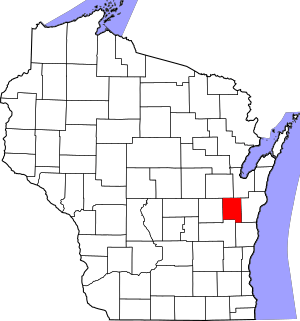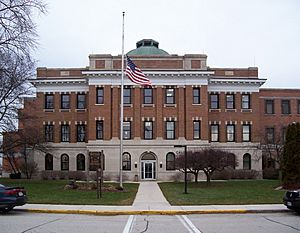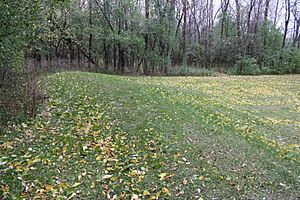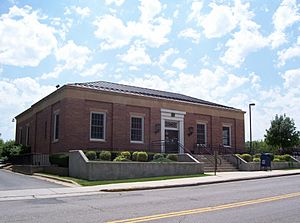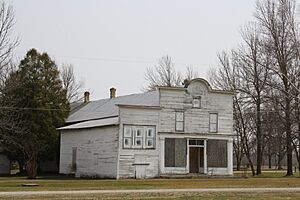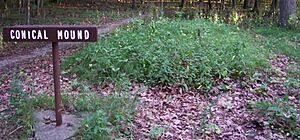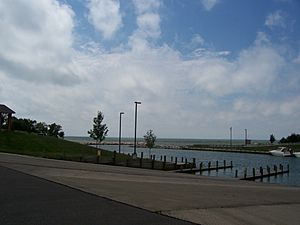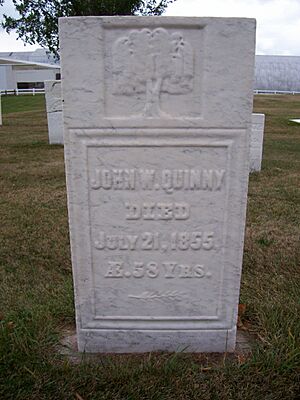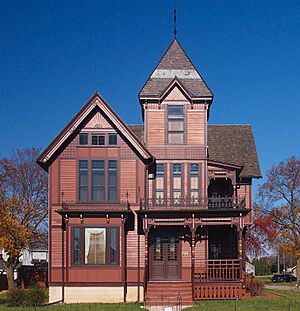National Register of Historic Places listings in Calumet County, Wisconsin facts for kids
This page lists special places in Calumet County, Wisconsin that are part of the National Register of Historic Places. Think of it like a national honor roll for buildings, sites, and objects that are important to American history, architecture, archaeology, engineering, or culture. These places are protected and celebrated for their unique stories.
There are 10 different places in Calumet County that have made it onto this important list. Let's explore some of them!
Contents
Historic Places in Calumet County
Aebischer Site (47CT30)
The Aebischer Site is a very old archaeological area located in the Killsnake Wildlife Area near Chilton. It contains traces of human activity from a huge span of time, starting about 11,000 years ago (around 9000 BC) all the way up to the 1900s. Scientists have found special stone tools called Clovis-like fluted points here, which were used by some of the earliest people in North America, known as Paleo-Indians.
Calumet County Courthouse
The Calumet County Courthouse is a grand building in Chilton. It was built in 1913 and designed by an architect named B. Mehner. The building has a style called Neoclassical, which means it looks a bit like ancient Greek and Roman temples, with columns and a big dome in the middle. It's a key part of the county's history and government.
Calumet County Park Group
At Calumet County Park near Hilbert, you can find six amazing effigy mounds. These are large earthworks shaped like animals or spirits, built by ancient Native American people. These particular mounds are thought to represent panthers or water spirits. They are located on a high ridge overlooking Lake Winnebago, which was an important place for these early communities.
Chilton Post Office
The Chilton Post Office, located on Main Street, is a red-brick building constructed in 1938. It was built during the Great Depression by the Public Works Administration, a government program that created jobs. The building is in the Georgian Revival style, which is a classic American look. Inside, there's a special mural painted in 1940 by Charles W. Thwaites, showing a scene called "Threshing Barley."
Haese Memorial Village Historic District
The Haese Memorial Village Historic District in Forest Junction is a small area that shows what a town looked like when it grew up around two railroad lines. When logging became less important and cars replaced trains, the town became smaller. The district includes buildings like the Haese General Store from 1884, a hardware store from 1908, and an old gas station from 1908. It's a snapshot of a bygone era.
High Cliff Mounds
Within High Cliff State Park near Sherwood, there's another group of effigy mounds. These ancient earthworks are found on the high cliffs overlooking Lake Winnebago. The mounds here include shapes of panthers, as well as simple conical (cone-shaped) and linear (line-shaped) mounds. They are important examples of Native American history and culture in the region.
Ridge Group
The Ridge Group is a collection of ancient mounds, enclosures, and burial grounds located near Brothertown. These structures were built by people of the Woodland period, a time in Native American history that stretched from about 1000 BC to 1000 AD. These sites offer clues about how these early communities lived and honored their dead.
Stockbridge Harbor
Stockbridge Harbor, near Stockbridge, is the site of an ancient village that might have been built around 1100 CE (about 900 years ago). This village was likely surrounded by a palisade, which is a fence made of strong wooden stakes for protection. It's believed that both effigy mound builders and Late Woodland people lived here, showing a mix of different cultures.
Stockbridge Indian Cemetery
The Stockbridge Indian Cemetery is a small burial ground located north of Stockbridge. It was used by a community of Stockbridge Indians who were farming in the area from the 1820s to 1856. Many of these people later moved to Shawano County. A notable person buried here is John Wannuaucon Quinney, an important leader of the Stockbridge Nation.
Herman C. Timm House
The Herman C. Timm House in New Holstein started as a small home in 1872. But in 1892, it was greatly expanded and remodeled into a grand house in the Stick style, which is known for its decorative wooden trim. Herman C. Timm was an immigrant from Germany who built a grain elevator, served as the village president, and even started a bank in New Holstein. Today, his house is a museum, telling the story of his life and the town's history.


